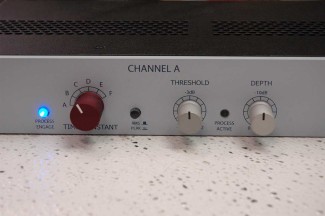by Scott Helmke
 Rupert Neve’s “Primary Source Enhancer” is a curious piece of gear. I’ll admit that when I first heard about it I laughed. What could it possibly do to justify that pretentious title?
Rupert Neve’s “Primary Source Enhancer” is a curious piece of gear. I’ll admit that when I first heard about it I laughed. What could it possibly do to justify that pretentious title?
It turned out that it does something very useful in the live sound world—making a lectern mic or a lavalier mic more stable and clear in a live situation.
So what does it do?
The 5045 is a dynamics processor, tailored specifically for voice applications. It lowers the signal between syllables and words, minimizing ringing before it can turn into feedback and also reducing ambience by diminishing the amount of room sound that gets back into the microphone
This is sort of like using an expander or noise gate, but with less artifacts and a much better result.
We typically use the 5045 in a couple different situations.
Most often we use the 5045 on lectern microphones, where it often gives us a more intelligible and several dB worth of extra gain before feedback.
The most dramatic application is on referee microphones at NCAA football games, where it significantly reduces the long echoes from the big loudspeaker systems needed to cover a 50,000 seat arena.
Setup and Usage of the 5045
Setting up and using the 5045 is relatively simple. It needs to be inserted in line with the source microphone, after a microphone preamp, since the 5045 operates at line level. The input signal level needs to be above -20 to -10 dB, so it may be necessary to boost the gain a bit on the mixer or preamp feeding the 5045.
Basic starting settings would typically have the Time Constant knob at “C,” Process Engage in, and Threshold and Depth at 12 o’clock.
The Peak/RMS button can be in either position, though I typically start with it out.
With a volunteer speaking through the microphone, adjust the Threshold knob until the Process Active light comes on fully during words but is dark between words. When the Process Active light is on the signal will be coming through full strength, and will be attenuated when the light is off. The Threshold knob has a relatively narrow range, so it may be necessary to send a hotter signal into the 5045 if the Process Active light stays dark.
With the basic threshold setting there should be reduced ambience and ringing. The next adjustment is to the Peak/RMS button, which affects how the 5045 detects signal. Try both settings and play with the threshold to see if there’s any additional improvement. This can make a big difference on a windy day at the football games.
The Time Constant and Depth knobs can be used to balance between a more natural sound versus reducing ringing and ambience. The Time Constant setting controls how quickly the 5045 adjusts gain to the microphone. The fastest setting of “A” is usually the most effective at reducing problems, but also has the most audible artifacts.
Depth affects how much the signal is attenuated between words, with the most clockwise setting of -20dB being the most effective but also with the most audible artifacts.
I typically use a Time Constant setting of “B” or “C” and leave the Depth setting at -10dB (12 o’clock), becoming more aggressive if I’m in a situation where I need intelligibility more than I need natural sound quality
If you’re looking to clear up the audio on a vocal lectern or lavalier microphone, the 5045 does a better job than any piece I’ve seen.
If you’re interested in renting the 5045, or anything else from our expansive rental inventory, please contact our Rental Team at 847-367-9588 or rentals@tcfurlong.com.
TC Furlong Inc. is also a Rupert Neve dealer, along with most other professional audio manufacturers. If you have questions about purchasing a 5045, or any other item from our line card of over 100 pro audio manufacturers, contact our Sales Team at 847-367-9588 or sales@tcfurlong.com.
![]() Subscribe today for educational posts, industry news, and more!
Subscribe today for educational posts, industry news, and more!
